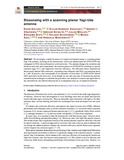Citation link:
http://dx.doi.org/10.25819/ubsi/10146| DC Field | Value | Language |
|---|---|---|
| crisitem.author.orcid | 0000-0002-9744-3419 | - |
| crisitem.author.orcid | 0000-0002-5836-5569 | - |
| crisitem.author.orcid | 0000-0003-3282-5982 | - |
| dc.contributor.author | Soltani, Navid | - |
| dc.contributor.author | Rabbany Esfahany, Elham | - |
| dc.contributor.author | Druzhinin, Sergey I. | - |
| dc.contributor.author | Schulte, Gregor | - |
| dc.contributor.author | Müller, Julian | - |
| dc.contributor.author | Butz, Benjamin | - |
| dc.contributor.author | Schönherr, Holger | - |
| dc.contributor.author | Agio, Mario | - |
| dc.contributor.author | Markešević, Nemanja | - |
| dc.date.accessioned | 2022-11-02T12:10:41Z | - |
| dc.date.available | 2022-11-02T12:10:41Z | - |
| dc.date.issued | 2022 | de |
| dc.description | Finanziert aus dem Open-Access-Publikationsfonds der Universität Siegen für Zeitschriftenartikel | de |
| dc.description.abstract | We investigate a model bioassay in a liquid environment using a z-scanning planar Yagi-Uda antenna, focusing on the fluorescence collection enhancement of ATTO-647N dye conjugated to DNA (deoxyribonucleic acid) molecules. The antenna changes the excitation and the decay rates and, more importantly, the emission pattern of ATTO-647N, resulting in a narrow emission angle (41°) and improved collection efficiency. We efficiently detect immobilized fluorescently-labeled DNA molecules, originating from solutions with DNA concentrations down to 1 nM. In practice, this corresponds to an ensemble of fewer than 10 ATTO-647N labeled DNA molecules in the focal area. Even though we use only one type of biomolecule and one immobilization technique to establish the procedure, our method is versatile and applicable to any immobilized, dye-labeled biomolecule in a transparent solid, air, or liquid environment. | en |
| dc.identifier.doi | http://dx.doi.org/10.25819/ubsi/10146 | - |
| dc.identifier.uri | https://dspace.ub.uni-siegen.de/handle/ubsi/2234 | - |
| dc.identifier.urn | urn:nbn:de:hbz:467-22343 | - |
| dc.language.iso | en | de |
| dc.rights | Attribution-NonCommercial-NoDerivatives 4.0 International | * |
| dc.rights.uri | http://creativecommons.org/licenses/by-nc-nd/4.0/ | * |
| dc.source | Biomedical Optics Express, 13 (2), S. 539-548, 2022. - https://doi.org/10.1364/BOE.445402 | de |
| dc.subject.ddc | 530 Physik | de |
| dc.subject.other | Biosensing | en |
| dc.subject.other | Yagi-Uda antenna | en |
| dc.subject.other | Yagi-Antenne | de |
| dc.subject.swb | Richtstrahler | de |
| dc.subject.swb | Biosensor | de |
| dc.subject.swb | Fluoreszenz | de |
| dc.title | Biosensing with a scanning planar Yagi-Uda antenna | en |
| dc.type | Article | de |
| item.fulltext | With Fulltext | - |
| ubsi.publication.affiliation | Department Physik | de |
| ubsi.source.issn | 2156-7085 | - |
| ubsi.source.issued | 2022 | de |
| ubsi.source.issuenumber | 2 | de |
| ubsi.source.pagefrom | 539 | de |
| ubsi.source.pageto | 548 | de |
| ubsi.source.publisher | Optica Publishing Group | de |
| ubsi.source.title | Biomedical Optics Express | de |
| ubsi.source.volume | 13 | de |
| ubsi.subject.ghbs | UKS | de |
| ubsi.subject.ghbs | URD | de |
| ubsi.subject.ghbs | YDD | de |
| Appears in Collections: | Geförderte Open-Access-Publikationen | |
Files in This Item:
| File | Description | Size | Format | |
|---|---|---|---|---|
| Biosensing_with_a_scanning_planar_Yagi-Uda_antenna.pdf | 3.1 MB | Adobe PDF |  View/Open |
This item is protected by original copyright |
Page view(s)
269
checked on Nov 25, 2024
Download(s)
67
checked on Nov 25, 2024
Google ScholarTM
Check
Altmetric
This item is licensed under a Creative Commons License


